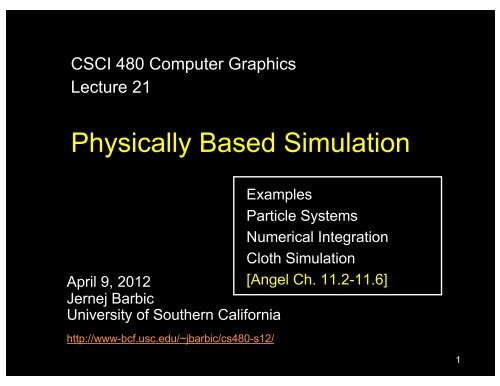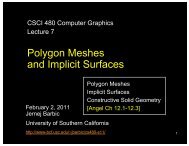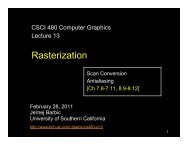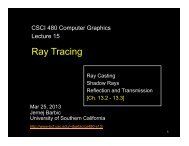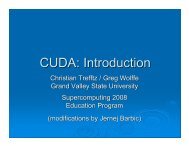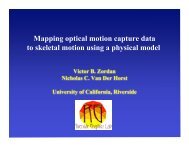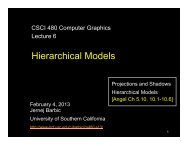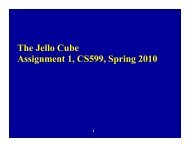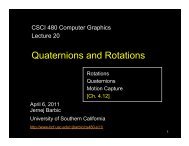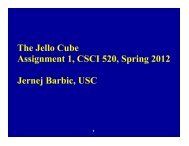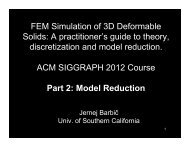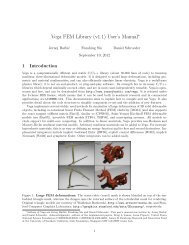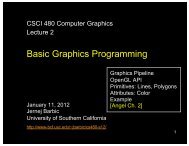Physically Based Simulation - University of Southern California
Physically Based Simulation - University of Southern California
Physically Based Simulation - University of Southern California
Create successful ePaper yourself
Turn your PDF publications into a flip-book with our unique Google optimized e-Paper software.
CSCI 480 Computer Graphics<br />
Lecture 21<br />
<strong>Physically</strong> <strong>Based</strong> <strong>Simulation</strong><br />
Cloth <strong>Simulation</strong><br />
April 9, 2012<br />
[Angel Ch. 11.2-11.6]<br />
Jernej Barbic<br />
<strong>University</strong> <strong>of</strong> <strong>Southern</strong> <strong>California</strong><br />
http://www-bcf.usc.edu/~jbarbic/cs480-s12/<br />
Examples<br />
Particle Systems<br />
Numerical Integration<br />
1
Physics in Computer Graphics<br />
• Very common<br />
• Computer Animation, Modeling<br />
(computational mechanics)<br />
• Rendering (computational optics)<br />
2
Physics in Computer Animation<br />
• Fluids<br />
• Smoke<br />
• Deformable strands (rods)<br />
• Cloth<br />
• Solid 3D deformable objects .... and many more!<br />
3
Fluids<br />
Enright, Marschner,<br />
Fedkiw,<br />
SIGGRAPH 2002<br />
4
Fluids and Rigid Bodies [Carlson, Mucha, Turk,<br />
SIGGRAPH 2004]<br />
5
Fluids with Deformable Solid Coupling<br />
[Robinson-Mosher,<br />
Shinar,<br />
Gretarsson,<br />
Su, Fedkiw,<br />
SIGGRAPH 2008]<br />
6
Deformations<br />
[Barbic and James,<br />
SIGGRAPH 2005]<br />
7
Source:<br />
ACM SIGGRAPH<br />
Cloth<br />
8
[Bridson, Fedkiw,<br />
Anderson, ACM<br />
SIGGRAPH 2002<br />
Cloth (Robustness)<br />
9
Simulating Large Models<br />
[Doug James,<br />
PhD Thesis, UBC, 2001]<br />
10
Sound <strong>Simulation</strong> (Acoustics)<br />
[James, Barbic, Pai,<br />
SIGGRAPH 2006]<br />
11
Multibody Dynamics<br />
12
Multibody Dynamics +<br />
Self-collision Detection<br />
[Barbic and James, SIGGRAPH 2010]<br />
13
Physics in Games<br />
[Parker and James,<br />
Symposium on Computer Animation 2009]<br />
14
Haptic Interfaces<br />
• hap·tic ('hap-tik)<br />
adj.<br />
Of or relating to the sense <strong>of</strong><br />
touch; tactile.<br />
15
Surgical <strong>Simulation</strong><br />
[James and Pai,<br />
SIGGRAPH 2002]<br />
16
Offline Physics<br />
• Special effects (film, commercials)<br />
• Large models:<br />
millions <strong>of</strong> particles / tetrahedra / triangles<br />
• Use computationally expensive rendering<br />
(global illumination)<br />
• Impressive results<br />
• Many seconds <strong>of</strong> computation time per frame<br />
17
Real-time Physics<br />
• Interactive systems:<br />
computer games<br />
virtual medicine (surgical simulation)<br />
• Must be fast (30 fps, preferably 60 fps for games)<br />
Only a small fraction <strong>of</strong> CPU time devoted to<br />
physics!<br />
• Has to be stable, regardless <strong>of</strong> user input<br />
18
Particle System<br />
• Basic physical system in computer graphics<br />
• We have N particles<br />
• They interact with<br />
some forces<br />
• Fire, Smoke, Cloth, ...<br />
• Very popular for its simplicity<br />
[William Reeves,<br />
SIGGRAPH 1983]<br />
19
• Newton’s 2nd law:<br />
Newton’s Laws<br />
!<br />
F =<br />
!<br />
ma<br />
• Gives acceleration, given the force and mass<br />
• Newton’s 3rd law: If object A exerts a force F on<br />
object B, then object B is at the same time<br />
exerting force -F on A.<br />
!<br />
F !<br />
F !<br />
20
Case Study: Mass-spring Systems<br />
• Mass particles<br />
connected by<br />
elastic springs<br />
• One dimensional:<br />
rope, chain<br />
• Two dimensional:<br />
cloth, shells<br />
• Three dimensional:<br />
s<strong>of</strong>t bodies<br />
Source:Matthias Mueller, SIGGRAPH<br />
21
Single spring<br />
• Obeys the Hook’s law:<br />
F = k (x - x 0)<br />
• x 0 = rest length<br />
• k = spring elasticity<br />
(stiffness)<br />
• For xx 0, spring<br />
wants to contract<br />
22
Hook’s law in 3D<br />
• Assume A and B two mass points connected<br />
with a spring.<br />
• Let L be the vector pointing from B to A<br />
• Let R be the spring rest length<br />
• Then, the elastic force exerted on A is:<br />
!<br />
! ! L<br />
F =<br />
! k (| L | ! R)<br />
!<br />
Hook<br />
| L<br />
|<br />
23
Damping<br />
• Springs are not completely elastic<br />
• They absorb some <strong>of</strong> the energy and tend to<br />
decrease the velocity <strong>of</strong> the mass points attached to<br />
them<br />
• Damping force depends on the velocity:<br />
! !<br />
F =<br />
! k v d<br />
• k d = damping coefficient<br />
• k d different than k Hook !!<br />
24
A network <strong>of</strong> springs<br />
• Every mass point connected to<br />
some other points by springs<br />
• Springs exert forces<br />
on mass points<br />
– Hook’s force<br />
– Damping force<br />
• Other forces<br />
– External force field<br />
• Gravity<br />
• Electrical or magnetic force field<br />
– Collision force<br />
25
Network organization is critical<br />
• For stability, must organize the network <strong>of</strong><br />
springs in some clever way<br />
Basic network Stable network Network out<br />
<strong>of</strong> control<br />
26
Time Integration<br />
Source:Andy Witkin, SIGGRAPH<br />
Physics equation:<br />
x’ = f(x,t)<br />
x=x(t) is particle<br />
trajectory<br />
27
Euler Integration<br />
x(t + Δt) = x(t) + Δt f(x(t))<br />
Source:Andy Witkin, SIGGRAPH<br />
Simple,<br />
but inaccurate.<br />
Unstable with<br />
large timesteps.<br />
28
Inaccuracies with explicit Euler<br />
Gain energy<br />
Source:Andy Witkin, SIGGRAPH<br />
“Blow-up”<br />
29
Midpoint Method<br />
Source:Andy Witkin, SIGGRAPH<br />
Improves stability<br />
1. Compute Euler step<br />
Δx = Δt f(x, t)<br />
2. Evaluate f at the midpoint<br />
f mid = f((x+Δx)/2, (t+Δt)/2)<br />
3. Take a step using the<br />
midpoint value<br />
x(t+ Δt) = x(t) + Δt f mid<br />
30
Many more methods<br />
• Runge-Kutta (4th order and higher orders)<br />
• Implicit methods<br />
– sometimes unconditionally stable<br />
– very popular (e.g., cloth simulations)<br />
– a lot <strong>of</strong> damping with large timesteps<br />
• Symplectic methods<br />
– exactly preserve energy, angular momentum and/or<br />
other physical quantities<br />
– Symplectic Euler<br />
31
Cloth <strong>Simulation</strong><br />
• Cloth Forces<br />
- Stretch<br />
- Shear<br />
- Bend<br />
• Many methods are<br />
a more advanced version<br />
<strong>of</strong> a mass-spring system<br />
• Derivatives <strong>of</strong> Forces<br />
– necessary for stability<br />
[Baraff and Witkin,<br />
SIGGRAPH 1998]<br />
32
Challenges<br />
• Complex Formulas<br />
• Large Matrices<br />
• Stability<br />
• Collapsing triangles<br />
• Self-collision detection<br />
[Govindaraju et al. 2005]<br />
33
Self-collisions: definition<br />
Deformable model is<br />
self-colliding iff<br />
there exist non-neighboring<br />
intersecting triangles.<br />
34
Bounding volume hierarchies<br />
AABBs<br />
Level 1<br />
AABBs<br />
Level 3<br />
[Hubbard 1995]<br />
[Gottschalk et al. 1996]<br />
[van den Bergen 1997]<br />
[Bridson et al. 2002]<br />
[Teschner et al. 2002]<br />
[Govindaraju et al. 2005]<br />
35
Bounding volume hierarchy<br />
root root<br />
36
Bounding volume hierarchy<br />
v<br />
w v w<br />
37
Real-time cloth simulation<br />
Model Triangles FPS<br />
% Forces +<br />
Stiffness<br />
Matrix<br />
% Solver<br />
Curtain 2400 25 67 33<br />
Source:<br />
Andy Pierce<br />
38
Multithreading implementation<br />
Source:<br />
Andy Pierce<br />
39
Summary<br />
• Examples <strong>of</strong> physically based<br />
simulation<br />
• Particle Systems<br />
• Numerical Integration<br />
• Cloth <strong>Simulation</strong><br />
40


